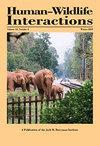Exotic Species
IF 0.9
4区 环境科学与生态学
Q4 BIODIVERSITY CONSERVATION
引用次数: 16
Abstract
-!ntre~u£-t~6ns Otsego Lake has had its share of invasions of nui sance aquatic organisms over the years. European carp (Cypril1us carpio) got into the lake in the 1800s and had important impacts on both animals and plants in the lake before those communi ties were even documented. In the 1930s curly leaved pondweed (Potamogetol1 crispus) arri ved and created a serious nuisance for star sailor~ and other keclboats e;.l.ch spring until it was sup planted by Eurasian mi Ifnil (Myriophyllum spicatum) which now dominates the vascular plant community in Otsego. A notorious aggres sive exotic, the milfoil has out competed curly leaved pondweed rendering it less of a problem. Milfoil itself. although abundant in the lake. creates less of a prob lem than is typical because we have at least four insects in the lake that feed on it preventing it form forming the massive beds that occur in most lakes hindering recreation. Several years ago another plant, south ern niaid (Nojos guodo /llpemis) appeared but has apparently had no negative effects. In 1990 European rudd (Scardinius erthroph tha/wns), a carplike fish closely related to our native golden shiner (Notemigol1us crysoleucas), got into the lake after being sold locally for fish bait. Unlike golden shiners, which never reach over 7 inches in Otsego, rudd are now are over a foot long. No one knows what impacts these carp-like fish will have. Alewife (A/oso pselldohorengus) was first recorded in Otsego Lake by Ru I'us Thayer who brought us a specimen he found in a lake trout stomach in 19Ro. Since then our greate. t chal lenge in mainraining water quality is been associated with attempts to control that popul'ltion. Water chest nllL~ (lm/w lI{/fallS • which crcate~ probl I1h in lakes and rivc:rs by completely covering the waters sUlf·acc. \ ere founcJ by BFS students in Otsego La~e ~e\ eral years l1l.':{). After removal they were nOI seen again until ConI. on p.2 INSIDE • 2008 Intcrns • Exotic Species Introduction.!....F. H. V. Mecklenburg High School Internship Awards • Updates外来物种
-!多年来,奥特塞哥湖一直受到外来水生生物入侵的影响。欧洲鲤鱼(塞浦路斯鲤鱼)在19世纪进入湖中,在这些群落被记录下来之前就对湖中的动植物产生了重要影响。在20世纪30年代,卷叶塘草(Potamogetol1 crispus)到达,给明星水手号和其他帆船造成了严重的麻烦。直到它被现在在奥特塞戈的维管植物群落中占主导地位的欧亚豆蔻(肉豆蔻)所补充。作为一种臭名昭著的侵略性外来物种,千叶草已经淘汰了竞争激烈的卷叶塘草,使其不那么成问题。耆草属植物本身。虽然在湖中丰富。造成的问题比典型的要少,因为我们在湖中至少有四种昆虫以它为食,防止它形成在大多数湖泊中出现的巨大的床,阻碍了娱乐。几年前出现了另一种植物,南方niaid (Nojos guodo - /llpemis),但显然没有负面影响。1990年,欧洲陆克鱼(Scardinius erthroph - tha/wns),一种与我们本土的金光鱼(Notemigol1us crysoleucas)密切相关的鱼状鱼,在当地作为鱼饵出售后进入湖中。在奥塞戈,金光鱼的长度永远不会超过7英寸,而现在陆龟的长度超过了一英尺。没有人知道这些像鲤鱼一样的鱼会有什么影响。阿莱弗(A/oso pselldohorengus)最早是由Ru I'us Thayer在Otsego湖记录的,他于1960年给我们带来了一个他在湖鳟鱼胃中发现的标本。从那时起,我们的伟大。维持水质的挑战与控制人口的努力有关。水箱- lll ~ (lm/w) l{/瀑布-通过完全覆盖水体sUlf·acc,在湖泊和河流中形成约1h。这是由BFS学生在Otsego La发现的~e ~e ~{{}。手术切除后,直到2010年才再次见到。在第19INSIDE•2008实习生•外来物种介绍!....F。H. V. Mecklenburg高中实习奖
本文章由计算机程序翻译,如有差异,请以英文原文为准。
求助全文
约1分钟内获得全文
求助全文
来源期刊

Human–Wildlife Interactions
Environmental Science-Nature and Landscape Conservation
CiteScore
2.80
自引率
0.00%
发文量
0
审稿时长
11 weeks
期刊介绍:
Human–Wildlife Interactions (HWI) serves the professional needs of the wildlife biologist and manager in the arena of human–wildlife conflicts/interactions, wildlife damage management, and contemporary wildlife management. The intent of HWI is to publish original contributions on all aspects of contemporary wildlife management and human–wildlife interactions with an emphasis on scientific research and management case studies that identify and report innovative conservation strategies, technologies, tools, and partnerships that can enhance human–wildlife interactions by mitigating human–wildlife conflicts through direct and indirect management of wildlife and increased stakeholder engagement. Our intent is to promote a dialogue among wildlife professionals concerning contemporary management issues. As such, we hope to provide a repository for wildlife management science and case studies that document and share manager experiences and lessons learned.
 求助内容:
求助内容: 应助结果提醒方式:
应助结果提醒方式:


